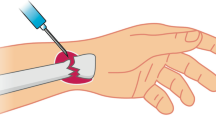Abstract
Hematoma blocks are useful to help control pain during fracture reduction. The principle is to inject the fracture hematoma itself with a local anesthetic, therefore directly anesthetizing the bony ends. Many fracture reductions are appropriate for a hematoma block, with the exceptions of open fractures, fractures greater than 2 days old, and fractures in the setting of possible infection. Superficial sites such as the distal radius, metacarpals, and ankle are the most commonly used because local landmarks are palpable and neurovascular anatomy is well defined. In general, local anesthetics without epinephrine should be used given the low volume needed and the risk of causing vascular injury in the digits and extremities.
Access provided by CONRICYT-eBooks. Download chapter PDF
Similar content being viewed by others
Keywords
Overview
Hematoma blocks are useful to help control pain during fracture reduction. The principle is to inject the fracture hematoma itself with a local anesthetic, therefore directly anesthetizing the bony ends. Many fracture reductions are appropriate for a hematoma block, with the exceptions of open fractures, fractures greater than 2 days old, and fractures in the setting of possible infection. Superficial sites such as the distal radius, metacarpals, and ankle are the most commonly used because local landmarks are palpable and neurovascular anatomy is well defined. In general, local anesthetics without epinephrine should be used given the low volume needed and the risk of causing vascular injury in the digits and extremities.
Equipment
-
1.
Sterile gloves
-
2.
Antiseptic
-
3.
20 gauge needle
-
4.
10 cc syringe
-
5.
Local anesthetic, typically 1 or 2% lidocaine
-
6.
Gauze
-
7.
Any casting or splinting materials needed for reduction
Technique
Patient consent should be obtained prior to an injection. If your institution requires a written consent or a procedural time-out, it should also be completed. Thoughtfully position your patient in a way that will allow easy access to the extremity for both the injection and the reduction that will follow. The joint should be approached from a safe direction that minimizes the risk to surrounding structures. Injury to a surrounding nerve or vessel is always a risk, and care should always be taken to avoid direct injection of anesthetic into a vessel. There should be minimal resistance to injection if the syringe is within the synovial space or fracture hematoma.
Author information
Authors and Affiliations
Corresponding author
Editor information
Editors and Affiliations
Rights and permissions
Copyright information
© 2017 Springer International Publishing AG
About this chapter
Cite this chapter
Hodax, J.D. (2017). Hematoma Block. In: Hodax, J., Eltorai, A., Daniels, A. (eds) The Orthopedic Consult Survival Guide. Springer, Cham. https://doi.org/10.1007/978-3-319-52347-7_8
Download citation
DOI: https://doi.org/10.1007/978-3-319-52347-7_8
Published:
Publisher Name: Springer, Cham
Print ISBN: 978-3-319-52346-0
Online ISBN: 978-3-319-52347-7
eBook Packages: MedicineMedicine (R0)




